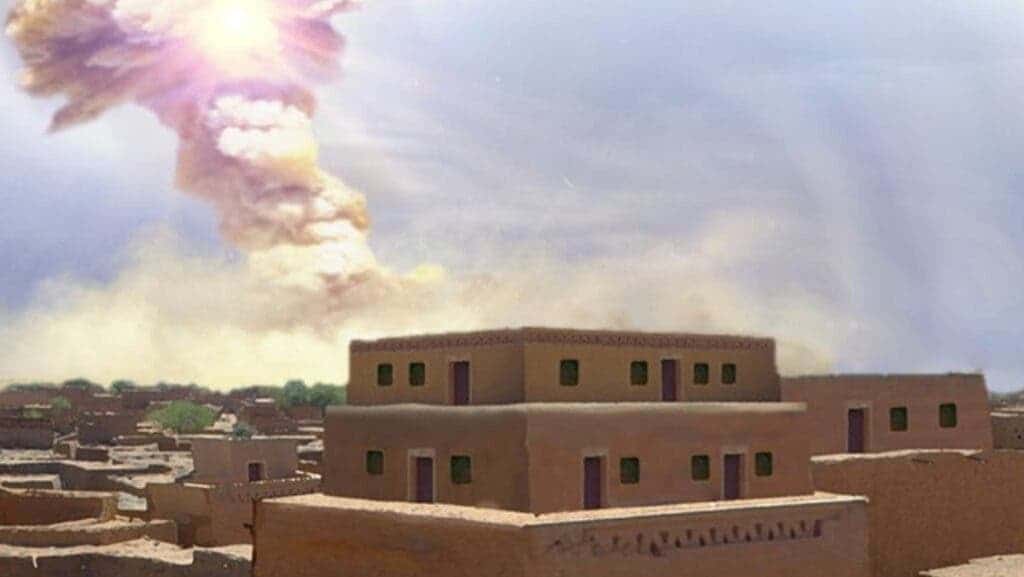The destruction of Tall el-Hamman, a vibrant city from the Bronze age located in the southern Jordan Valley, could have inspired the story of Sodom and Gomorrah, two legendary biblical cities that were destroyed by God becoming too wicked.

About 3,600 years ago, Tall el-Hamman was the largest continuously occupied city in the southern Levant, having hosted people for a few thousand years. It was the political center of the valley, alongside the cities of Jericho and Tell Nimrin. More than 50,000 people lived in the area, which hosted mudbrick buildings up to five stories tall.
The site has been frequently visited by archaeologists and biblical scholars as it hosts valuable cultural evidence, all compacted into layers of dirt and rock as the settlement was built, destroyed, and rebuilt over the years. But there’s a specific internal in the Middle Bronze Age layer that recently caught the eye of a group of researchers.
In addition to what you would expect to find from destruction from earthquakes and warfare, the researchers also found pottery shards with surfaced melted into glass and partially melted building material. This would indicate an anomalously high-temperature event, which they think was a space rock raising havoc in the city.
“Flashing through the atmosphere, the rock exploded in a massive fireball about 2.5 miles above the ground. The blast was around 1,000 times more powerful than the Hiroshima atomic bomb. The shocked city dwellers who stared at it were blinded instantly. Air temperatures rapidly rose above 2,000ºC,” writes co-author Christopher Moore, for the Conversation.
Seconds after the meteorite, a shock from the explosion smashed into the city, Moore said. It moved at about 740 miles per hour, with deadly winds demolishing every building. None of the 8,000 people living at the moment in Tall el-Hamman or any animals survived, Moore wrote, with their bodies torn apart and their bodies blasted into fragments.
A long-term research
Getting some answers of what actually happened in Tall el-Hamman took almost 15 years of excavations by hundreds of people, then followed by detailed analyses of the excavated material. Archaeologists, geologists, geochemists, cosmic-impact experts, medical doctors, and mineralogists participated in the remarkable research effort.

After dismissing an earthquake, a fire, and a volcanic eruption as possible cataclysmic events, the researchers concluded that a small asteroid must have been the main culprit behind the city’s destruction. It was likely similar to the one that cleared out 80 million trees in Tunguska, Russia, in 1908, and much smaller than the one that took out the dinosaurs about 65 million years ago, Moore explained.
The researchers found finely fractured sand grains called shocked quartz that is only formed at 725,000 pounds per square inch of pressure. The layer of dirt also had very small diamondoids — variants of a carbon cage molecule that are as hard as diamonds. Woods and plants in Tall el-Hamman turned into these diamond-like materials because of the temperature and high pressure from the space rock.
At the laboratory, experiments also showed that the pottery and mudbricks at Tall el-Hammam melted at temperatures above 1.500ºC – hot enough to melt a car in minutes. The surfaces of the pottery are also spattered with small melted metallic grains, such as iridium, platinum and zirconium silicate, with a melting point over 1.500ºC
The researchers believe that the oral description of the city’s destruction was passed down from generation to generation until it was registered as the story of the Sodom and Gomorrah. The Bible describes an urban center near the Dead Sea that was fully devastated by stones and fire falling from the sky, killing all the city’s inhabitants.
“Could this be an ancient eyewitness account? If so, the destruction of Tall el-Hammam may be the second-oldest destruction of a human settlement by a cosmic impact event, after the village of Abu Hureyra in Syria about 12,800 years ago. Importantly, it may the first written record of such a catastrophic event,” Moore writes.
The study was published in the journal Scientific Reports.


